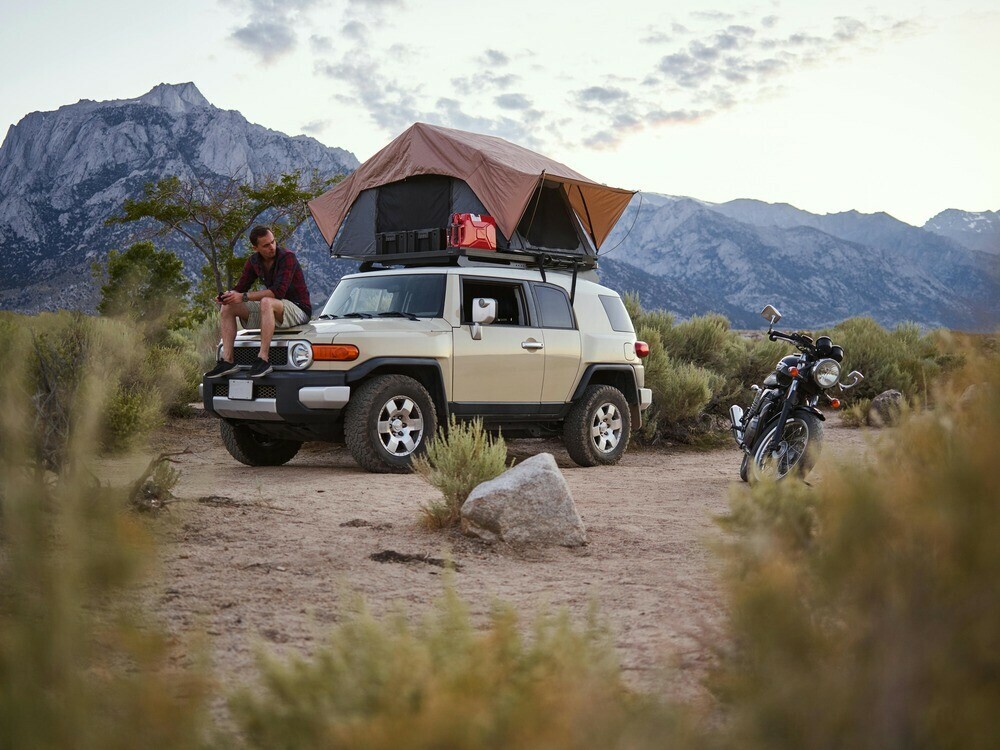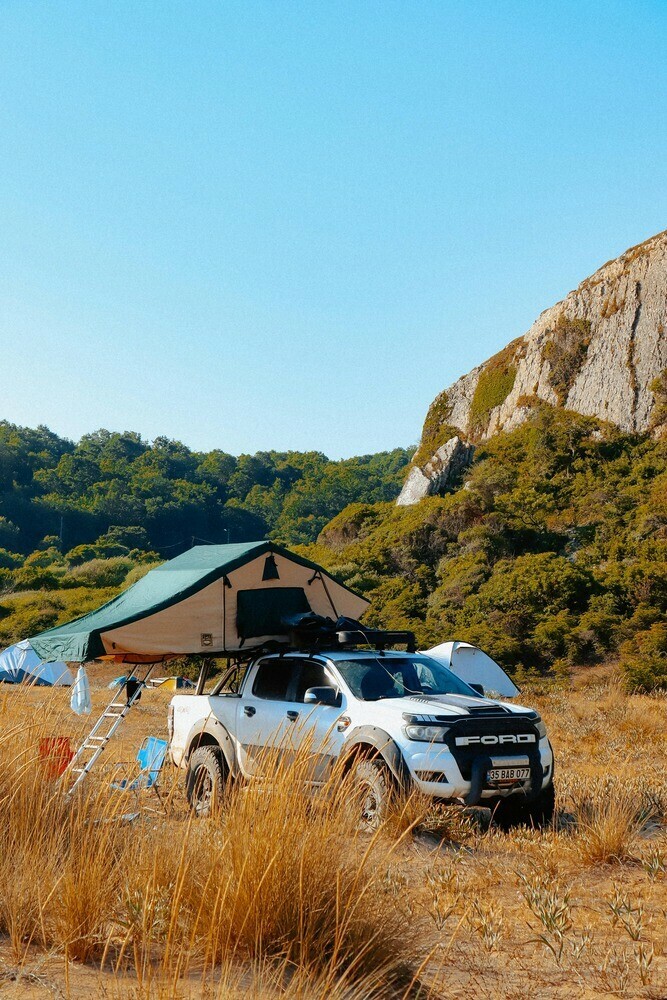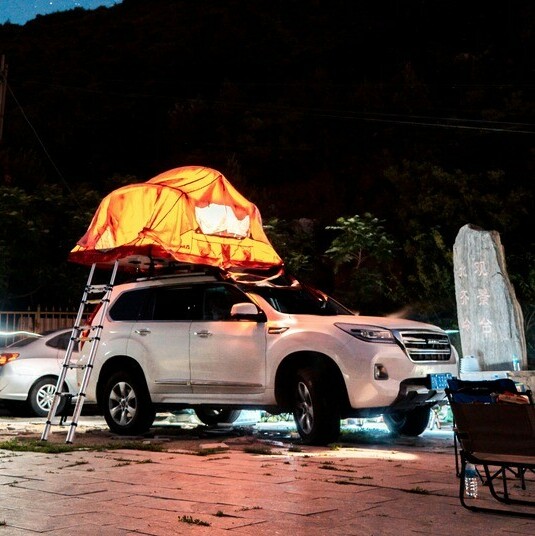Considering a vehicle roof-top tent? Discover the pros and cons, real-life experiences, and expert insights on whether you should invest in one for your adventures. Explore the versatility, enhanced camping experience, and safety benefits of VRTs, alongside practical considerations like installation, weather limitations, and storage. Delve into personal anecdotes, expert interviews, and comprehensive guidance to help you make an informed decision. Whether you’re a seasoned outdoor enthusiast or a curious novice, this guide offers invaluable insights to elevate your camping game to new heights. So, Vehicle Roof-Top Tents: Would I Recommend Them? Well, let`s find out.
 Image is courtesy of ArtHouse Studio Pexels
Image is courtesy of ArtHouse Studio Pexels
Elevate Your Camping Experience with Vehicle Roof-Top Tents
Picture this, a crisp morning breeze gently rustling the leaves, the aroma of freshly brewed coffee wafting through the air, and a breath-taking panoramic view greeting you as you step out of your tent. But here’s the twist, your tent isn’t pitched on the ground, it’s perched atop your vehicle, offering a whole new perspective on the great outdoors. In today’s fast-paced world, where every moment counts and every adventure beckons, vehicle roof-top tents (VRTs) have emerged as game-changers for outdoor enthusiasts. But are they truly worth the hype? Let’s delve deeper.
With a VRT, your camping experience transcends the ordinary. No longer confined to flat ground, you’re free to explore rugged terrains, remote landscapes, and hidden gems inaccessible to traditional tents. But beyond the allure of adventure lies a myriad of considerations, from the practicalities of installation and setup to the awe-inspiring vistas awaiting you at dawn. Join us as we embark on a journey to uncover the pros and cons of vehicle roof-top tents, drawing insights from real-life experiences and expert opinions. From the thrill of sleeping under the stars to the challenges of braving the elements, we’ll leave no stone unturned in our quest to help you make an informed decision.
What Are Vehicle Roof-Top Tents?
Vehicle roof-top tents (VRTs) represent a revolutionary approach to camping, offering a portable and elevated shelter solution for outdoor enthusiasts. Unlike traditional ground tents, VRTs are designed to be mounted on the roof of a vehicle, providing campers with a comfortable and secure sleeping space above ground level.
One of the key advantages of VRTs is their versatility. These tents are suitable for various terrains and weather conditions, making them ideal for adventurous souls seeking to explore remote and rugged landscapes. Whether you’re traversing rocky mountain trails or navigating sandy desert dunes, a VRT offers a reliable shelter option that adapts to your environment.
Furthermore, VRTs enhance the overall camping experience by providing campers with unique advantages that traditional ground tents simply cannot match. From panoramic views of the surrounding scenery to improved ventilation and airflow, sleeping in a VRT offers a refreshing and immersive outdoor experience. Imagine waking up to the gentle glow of the sunrise, with nothing but clear skies and unobstructed vistas stretching out before you.
In addition to their practical benefits, VRTs also offer safety advantages for campers. By elevating your sleeping quarters above ground level, you can enjoy added protection from wildlife and ground-based hazards. Whether you’re concerned about curious critters rummaging through your campsite or unexpected rainfall causing flooding, a VRT provides peace of mind knowing that you’re safely above it all.
 Image courtesy of Ayşenur Sağlam Pexels
Image courtesy of Ayşenur Sağlam Pexels
Pros of Vehicle Roof-Top Tents
Vehicle roof-top tents (VRTs) offer a range of benefits that make them a popular choice among outdoor enthusiasts. Understanding these advantages can help you determine whether a VRT is the right camping solution for your needs.
Firstly, VRTs provide an enhanced camping experience by elevating your sleeping quarters above ground level. This not only offers spectacular views of your surroundings but also helps to keep you safe from potential hazards such as flooding, wild animals, or insects. Imagine waking up to the sight of a breath-taking sunrise or falling asleep under a canopy of twinkling stars, all from the comfort of your rooftop tent.
Moreover, VRTs are incredibly versatile, making them suitable for a wide range of camping environments. Whether you’re embarking on a rugged off-road adventure or simply spending a weekend at a campsite, a VRT can provide a comfortable and secure shelter option. Their sturdy construction and weather-resistant materials ensure that you stay protected from the elements, no matter where your travels take you.
Additionally, VRTs offer space-saving benefits for campers with limited storage space or compact vehicles. Unlike traditional ground tents that require ample ground space for setup, VRTs utilize the roof of your vehicle, freeing up valuable space for other camping gear or equipment. This makes them particularly well-suited for outdoor enthusiasts who enjoy off-road adventures or exploring remote destinations where space is at a premium.
Cons of Vehicle Roof-Top Tents
While vehicle roof-top tents (VRTs) offer numerous advantages, it’s important to consider some potential drawbacks before making a decision.
One of the primary concerns with VRTs is their cost. Compared to traditional ground tents, VRTs tend to be more expensive, requiring a significant initial investment. Additionally, there may be additional expenses associated with accessories such as roof racks, mounting systems, or awnings. However, many outdoor enthusiasts argue that the long-term benefits and enhanced camping experience justify the upfront cost of a VRT.
Another consideration is the installation and setup process. Unlike ground tents that can be pitched in a matter of minutes, VRTs require more time and effort to install properly. This may involve securing the tent to the roof of your vehicle, adjusting the tension of the fabric, and ensuring that all components are properly aligned. While this process may be daunting for some campers, others view it as part of the adventure and enjoy the sense of accomplishment that comes with mastering the setup.
Furthermore, VRTs may have limitations in extreme weather conditions. While they are designed to withstand moderate wind and rain, they may not offer the same level of protection as traditional ground tents in harsh weather environments. Additionally, extreme temperatures can pose challenges for campers sleeping in VRTs, as they may struggle to stay warm in cold weather or cool in hot weather. However, with proper preparation and equipment, many campers find that they can comfortably weather the elements in their VRT.
 Image courtesy of JackerKun Pexels
Image courtesy of JackerKun Pexels
Cost of Roof-Top Tents
Here are a few rough estimates of the cost of roof-top tents:
Tepui Explorer Series Kukenam 3: £1,500 – £1,800
iKamper Skycamp 2.0: £3,000 – £3,700
ARB Simpson III Rooftop Tent: £1,200 – £2,000
Smittybilt Overlander Tent: £900 – £1,200
These prices are approximate as of 2024 and may vary depending on factors such as brand, model, features, and retailer. It’s essential to research thoroughly and compare prices from various sources to find the best deal for your budget and camping needs.
Real-Life Experiences
Here are a couple of reviews of popular roof-top tents:
Review of the Thule Tepui Explorer Series Kukenam 3
“I recently purchased the Thule Tepui Explorer Series Kukenam 3 and I am more than happy with my decision. The tent is incredibly spacious, comfortably accommodating myself and my partner with room to spare. The setup process was straightforward, and the quality of materials was evident in every detail. We’ve taken it on several camping trips, including off-road adventures, and it has held up admirably in various weather conditions. Overall, I highly recommend the Tepui Kukenam 3 for anyone in search of a reliable and comfortable roof-top tent.” – (John D., Outdoor Enthusiast)
Review of the iKamper Skycamp 2.0
“After much research, I decided to invest in the iKamper Skycamp 2.0, and it has exceeded my expectations in every way. The hard shell roof provides added protection and peace of mind, while the expandable sleeping area offers ample space for my family of four. Setup is a breeze, thanks to the innovative design, and the tent feels incredibly sturdy once mounted on my vehicle. We’ve used it on weekend getaways and extended camping trips, and it has proven to be a comfortable and reliable home away from home. If you’re looking for a versatile and well-built roof-top tent, the iKamper Skycamp 2.0 is an excellent choice.” – (Sarah M., Camping Enthusiast)
Exploring the pros and cons of vehicle roof-top tents (VRTs) through real-life experiences can offer valuable insights for prospective campers.
Many VRT owners praise the space-saving benefits of these tents, particularly for those with compact vehicles or limited storage space. By utilizing the roof of their vehicle for sleeping quarters, campers can free up valuable space inside their vehicle for other camping gear or equipment. This not only enhances the overall camping experience but also allows for greater flexibility when packing for trips.
Additionally, VRT owners often highlight the sense of security and peace of mind that comes with sleeping above ground level. Unlike traditional ground tents, which are susceptible to flooding, wildlife intrusion, or uneven terrain, VRTs offer an elevated and secure sleeping platform. This can be particularly reassuring for campers venturing into remote or unfamiliar environments, where unpredictable conditions may pose challenges during the night.
Moreover, VRT owners appreciate the versatility of these tents, which are suitable for various camping environments and weather conditions. Whether you’re embarking on a rugged off-road adventure or spending a weekend at a campsite, a VRT offers a reliable shelter option that adapts to your surroundings. From star-gazing in the desert to weathering a storm in the mountains, VRTs provide a comfortable and secure haven for outdoor enthusiasts seeking adventure.
 Image courtesy of Uriel Mont Pexels
Image courtesy of Uriel Mont Pexels
Expert Insights
Gaining expert insights into the world of vehicle roof-top tents (VRTs) can provide valuable guidance for prospective campers.
Outdoor enthusiasts and professionals often stress the importance of selecting the right VRT for your specific needs and preferences. With a wide range of brands, models, and features available on the market, it’s essential to consider factors such as tent size, weight, material quality, and ease of installation. By consulting with experts or experienced campers, you can gain valuable recommendations and insights to help you make an informed decision.
Furthermore, experts offer valuable advice on maintenance tips and best practices for prolonging the lifespan of VRTs. Regular maintenance, such as cleaning the tent fabric, lubricating moving parts, and inspecting for wear and tear, can help ensure that your VRT remains in optimal condition for years to come. Additionally, experts may provide recommendations for accessories or add-ons that can enhance the functionality and comfort of your VRT, such as annexe rooms, awnings, or additional storage solutions.
In conclusion, seeking expert insights and advice can help you navigate the world of vehicle roof-top tents with confidence. By leveraging their knowledge and experience, you can make the correct decisions, maximize the enjoyment of your outdoor adventures, and ensure that your VRT stands the test of time.
 Image courtesy of Taryn Elliott Pexels
Image courtesy of Taryn Elliott Pexels
Addressing Common Queries
Addressing common queries about vehicle roof-top tents (VRTs) can help alleviate concerns and provide clarity for prospective campers.
One common question is, are VRTs are suitable for all vehicles. While VRTs are compatible with many types of vehicles, including SUVs, trucks, and even some cars with roof racks, it’s important to ensure that your vehicle can support the weight and size of the tent. Consult with the manufacturer or a professional installer to determine if your vehicle is compatible and what modifications may be necessary for proper installation.
Another frequently asked question is about the impact of VRTs on fuel efficiency and vehicle handling. While adding a VRT to your vehicle may affect its aerodynamics and increase wind resistance, the impact on fuel efficiency is typically minimal. However, it’s essential to consider the added weight and height of the tent when driving, particularly in windy or gusty conditions. Additionally, some campers may experience changes in vehicle handling, such as increased body roll or reduced manoeuvrability, when driving with a loaded roof-top tent. Practicing safe driving habits and adjusting your driving style accordingly can help mitigate these effects.
Additionally, many campers inquire about the installation and setup process for VRTs. While some may find the process daunting at first, with practice and patience, it becomes more manageable over time. Following the manufacturer’s instructions and seeking guidance from experienced campers or professionals can help ensure a smooth and successful installation. Moreover, many VRT owners find that the sense of accomplishment and freedom that comes with setting up their rooftop tent adds to the overall adventure of camping.
In conclusion, addressing common queries about VRTs can help prospective campers make informed decisions and enjoy a rewarding outdoor experience. By understanding the compatibility, impact on fuel efficiency and handling, and installation process of VRTs, you can embark on your camping adventures with confidence and peace of mind.
Conclusion
In conclusion, weighing the pros and cons of vehicle roof-top tents (VRTs) is essential for anyone considering investing in this camping solution. By examining the various aspects discussed in this article, you can make an informed decision that aligns with your outdoor adventure goals and preferences.
While VRTs offer numerous advantages, including enhanced camping experiences, versatility, and safety benefits, it’s important to acknowledge the potential drawbacks, such as cost, installation complexity, and weather limitations. By understanding these factors, you can better assess whether a VRT is the right choice for your camping needs.
Ultimately, the decision to invest in a VRT depends on your individual preferences, budget, and camping style. Whether you’re a seasoned outdoor enthusiast seeking to elevate your camping experience or a novice camper embarking on your first adventure, VRTs offer a unique and exciting way to connect with nature and explore the great outdoors.
So, as you contemplate your next camping adventure, consider the insights and guidance provided in this article. Whether you choose to embark on a journey with a vehicle roof-top tent or opt for traditional camping methods, may your outdoor experiences be filled with joy, discovery, and unforgettable memories. Happy camping!


